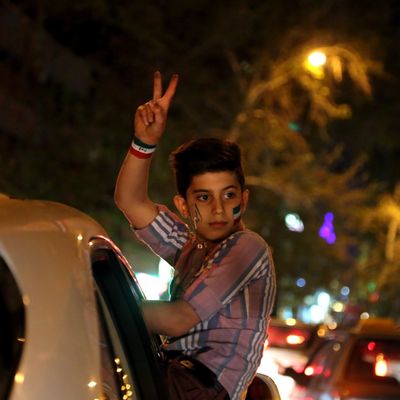
One effect of social media is to test the strength of cliché. The first reports out of Tehran after the news that Iranian foreign minister Mohammad Javad Zarif and U.S. secretary of State John Kerry had reached a tentative deal to end U.S. sanctions on the country were that Iranians were dancing in the streets, that traffic had been stopped. On Instagram and Twitter, it was soon possible to find proof that this was literally so: There were men dancing in the middle of a long line of cars; here was noisy, celebratory honking backlit by purple streetlights. Exactly how many people were dancing and how much traffic had been stopped was hard to say through the pinhole view the West has of Tehran: Cosmopolitan liberals maintain a structural Instagram advantage in oppressive places that tends to outweigh their actual political might. Nevertheless, when a tiny hardliner counterprotest materialized outside of the Iranian Parliament — 200 men carrying handwritten signs — it seemed pretty lifeless by comparison.
Coverage of Iran is inescapably dour, filled with the fretting of ex-Senate staffers, always punctuated by the dire warnings of Israeli prime minister Benjamin Netanyahu and then the chastising voice of the New York Times editorial board explaining that Netanyahu is overdramatizing things, rebounding off him in echo. It is hard not to be optimistic about the deal; it is also hard not to notice the essential strangeness of an arrangement that leaves Iran permanently on the brink of attaining the bomb while insisting that it will never be allowed to actually do so. And yet it has felt that the story has a different dimension this time, a little more hopeful. The celebrations in Iran are reminders that this is, for some people, not a deal executed by distant men in suits, but something like liberation from a crippling sanctions regime that has, in one form or another, been in place since 1979. You can say a lot for and against Obama’s foreign policy, but in the last 12 months, he has opened both Havana and Tehran. Which is at least something.
In Washington, sanctions are almost always the wuss option. Our foreign-policy debates take place within an environment of peculiar abstraction — there is always a realist position and an idealist one, always a hawk to balance the dove — and so the political reaction tends to focus mostly on what would happen if we sent troops or bombs, and very little on what might happen if we tightened the economic noose. But on the receiving end, as it tends to fall to underfunded human-rights groups to point out, they are horrible. In 2012, after the latest round of sanctions, the economist and E.U. adviser Mehrdad Emadi reported that 40 percent of men working in Iran’s largest cities lost their jobs. Meanwhile, the country endured a crippling inflation — in one memorable, terrible episode, the price of chicken tripled, Iranians waited six hours to buy chicken to eat, and the Tehran police chief urged television networks not to broadcast images of people eating chicken because they would incite class conflict. In some basic calculation, the sanctions worked — surely they played some role in prompting the Iranian government to negotiate. And yet the low-grade bureaucratic atmosphere of sanctions in progress — below the radar of news events, the Treasury Department enforced the sanctions with extreme vigilance, at one point fining the men’s pro tennis tour for hiring an Iranian chair umpire — has given them a dual life: invisible here, brutal there.
Already the émigré opportunists and airplane manufacturers are beginning to flood in, shysters being the amuse-bouche of capitalist freedom. One question is what society will greet them. The cosmopolitan life of Tehran under oppression has flickered into view every now and then during the past few years, especially in the 2009 Green Revolution, but also in small doses all along — in, for instance, the viral video of six young Iranian kids dancing around to Pharrell Williams’s “Happy.” (The Times has a nicely done casual video series about daily life in Tehran by its bureau chief there, the Dutch journalist Thomas Erdbrink.) There’s usually a turn in these stories, a reminder of how gothic and oppressive Iran’s regime still is — the Green Revolution was crushed, after all, and those six dancing kids were arrested — and what a minority the liberals are. But the story in Tehran this week hasn’t only been about liberals and conservatives, the fitful enumerating of how many of each there are. It is also that it wasn’t just cosmopolitan hipsters who had cause to stop traffic and dance outside their cars. It was any Iranian who wanted a reason to hope that their lives might soon be a little bit easier.





























